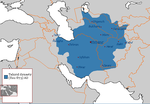Tahirid dynasty
Tahirid Dynasty Tâheriyân | |||||||||||
|---|---|---|---|---|---|---|---|---|---|---|---|
| 821–873 | |||||||||||
 Provinces governed by the Tahirids | |||||||||||
| Status | De jure governorate of the Abbasid Caliphate[1] | ||||||||||
| Capital | Merv, later Nishapur | ||||||||||
| Common languages | Early New Persian (court, informal)[2][3] Arabic (literature/poetry/science)[4] | ||||||||||
| Religion | Sunni Islam | ||||||||||
| Government | Caliphal governoral emirate | ||||||||||
| Emir | |||||||||||
• 821 | Tahir ibn Husayn | ||||||||||
| Historical era | Medieval | ||||||||||
• Established | 821 | ||||||||||
• Disestablished | 873 | ||||||||||
| Area | |||||||||||
| 800 est.[5] | 1,000,000 km2 (390,000 sq mi) | ||||||||||
| |||||||||||
The Tahirid dynasty (
The Tahirids, however, were not an independent dynasty—according to Hugh Kennedy: "The Tahirids are sometimes considered as the first independent Iranian dynasty, but such a view is misleading. The arrangement was effectively a partnership between the Abbasids and the Tahirids." Indeed, the Tahirids were loyal to the Abbasid caliphs and in return enjoyed considerable autonomy; they were in effect viceroys representing Abbasid rule in Persia.[6][7] The tax revenue from Khorasan sent to the caliphal treasury in Baghdad was perhaps larger than those collected previously.[6]
Rulers of Khurasan
Rise
The founder of the Tahirid dynasty was
Tahir's other son, Abdullah, was instated as the wali of Egypt and the Arabian Peninsula, and when Talha died in 828 he was given the governorship of Khorasan. Abdullah is considered one of the greatest of the Tahirid rulers,[12] as his reign witnessed a flourishing of agriculture in his native land of Khorasan, popularity in the eastern lands of the Abbasid caliphate and expanding influence due to his experience with the western parts of the caliphate. A noted poet, he sympathized with all things Arabic.[16]
The replacement of the
Fall

Abdullah died in 844 and was succeeded by his son
Governors of Baghdad
Besides their hold over Khorasan, the Tahirids also served as the military governors (ashab al-shurta) of Baghdad, beginning with Tahir's appointment to that position in 820. After he left for Khorasan, the governorship of Baghdad was given to a member of a collateral branch of the family, Ishaq ibn Ibrahim, who controlled the city for over twenty-five years.[19] During Ishaq's term as governor, he was responsible for implementing the Mihna (inquisition) in Baghdad.[20] His administration also witnessed the departure of the caliphs from Baghdad, as they made the recently constructed city of Samarra their new capital.[21] When Ishaq died in 849 he was succeeded first by two of his sons, and then in 851 by Tahir's grandson Muhammad ibn Abdallah.[19]
Abdallah played a major role in the events of the "
Language and culture
The historian
Centuries later, both 'Aufi and Daulatshah wrote the Tahirids were hostile to Persian literature.[26] 'Abd-Allah b. Tahir ordered the Persian novel Vamiq-u Adhra "The Ardent Lover and the Virgin" (based on a Hellenistic novel[27]) and other Persian and Zoroastrian works destroyed, according to Daulatshah.[26]
However, according to the historian Shivan Mahendrarajah, in reference to the dynasties of the Iranian Intermezzo of which the Tahirids are considered part:[28]
Persian (the language) and Iranian (the identity) were reasserting themselves. Iranians were adapting Arab-Islamic cultural tenets through a process of 'take the best, leave the rest'.
Within this context, Mahendrarajah adds that the Tahirids were specifically responsible for initiating the process by which Persian became written in the
The Tahirids claimed descent from Rustam, the mythological Iranian hero.[29]
The art historian Sheila Blair explains that the Tahirids may well have added Persian inscriptions to their (now non-extant) buildings.[30]
Members of the Tahirid dynasty
| Governor[31] | Term |
|---|---|
| Governors of Khurasan | |
| Tahir ibn Husayn | 821–822 |
| Talha ibn Tahir | 822–828 |
| Abdallah ibn Tahir al-Khurasani | 828–845 |
| Tahir (II) ibn Abdallah | 845–862 |
| Muhammad ibn Tahir (II) | 862–873 |
| Governors of Baghdad | |
| Tahir ibn Husayn | 820–822 |
| Ishaq ibn Ibrahim al-Mus'abi | 822–850 |
| Muhammad ibn Ishaq ibn Ibrahim | 850–851 |
| Abdallah ibn Ishaq ibn Ibrahim | 851 |
| Muhammad ibn Abdallah ibn Tahir | 851–867 |
| Ubaydallah ibn Abdallah ibn Tahir | 867–869 |
| Sulayman ibn Abdallah ibn Tahir | 869–879 |
| Ubaydallah ibn Abdallah (again) | 879–885 |
| Muhammad ibn Tahir (II) | 885–890 |
| Ubaydallah ibn Abdallah (again) | 890–891 |
Family tree
| History of Afghanistan | |
|---|---|
 | |
| Timeline | |
| 410–557 | |
| Nezak Huns | 484–711 |
| History of Iran | |
|---|---|
 | |
| 3200–2700 | |
| Jiroft culture | c. 3100–2200 |
| Lullubi Kingdom/Zamua | c. 3100-675 |
| Elam | 2700–539 |
| Marhaši | c. 2550-2020 |
| Oxus Civilization | c. 2400–1700 |
| Akkadian Empire | 2400–2150 |
| Kassites | c. 1500–1155 |
| Avestan period | c. 1500–500 |
| Neo-Assyrian Empire | 911–609 |
| Urartu | 860–590 |
| Mannaea | 850–616 |
| Zikirti | 750-521 |
| Saparda | 720-670 |



